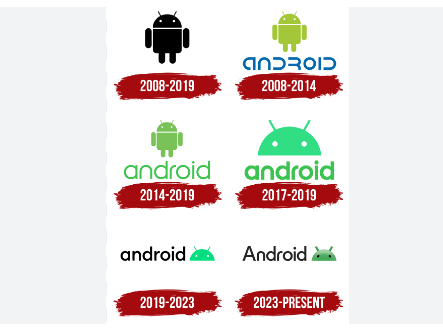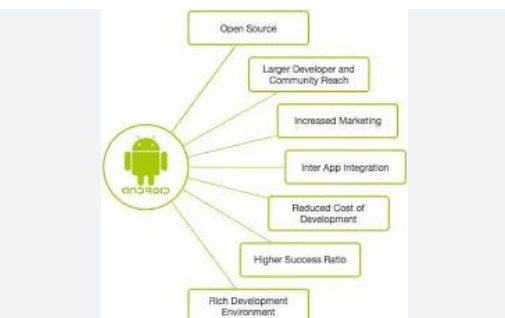Discover Android: The Ultimate Guide to Mobile Innovation
In the realm of mobile technology, Android stands as a revolutionary force, driving innovation and shaping the way we interact with our devices. Since its inception, Android has grown into the world’s most popular mobile operating system, powering billions of devices globally. This guide explores the key aspects of Android, its history, features, and the reasons behind its widespread success.

Table of Contents
The Evolution of Android
An-droid journey began in 2003 when Andy Rubin co-founded Android Inc., initially focusing on operating systems for digital cameras. However, the vision soon shifted to mobile devices, leading to Google’s acquisition of the company in 2005.

The first commercial version, Android 1.0, was released in 2008 on the HTC Dream, also known as the T-Mobile G1. This marked the beginning of an era of rapid development and growth.
Early Development and Growth
Android 1.0, the first commercial version of the operating system, was introduced in 2008 on the HTC Dream, also known as the T-Mobile G1.
This initial release marked a significant milestone in mobile technology, offering a new alternative to existing smartphone operating systems like Symbian and Windows Mobile.
Android 1.0 introduced basic smartphone functionalities such as web browsing, email, and access to Google services like Google Maps. This foundational version laid the groundwork for the rapid evolution and growth that Android would experience in the years to come.

The Vision Behind Android
The inception of Android dates back to 2003 when Andy Rubin co-founded Android Inc. with the goal of creating a powerful, flexible operating system for digital cameras. However, recognizing the broader potential of the mobile market, the company pivoted to focus on smartphones.
In 2005, Google acquired Android Inc., a strategic move that underscored Google’s commitment to entering the mobile space. The acquisition brought Rubin and his team into Google, where they continued to develop the Android operating system with the vision of creating an open-source platform that could be adopted by a wide range of manufacturers.
Launching Android 1.0
The release of An-droid 1.0 was a significant achievement, featuring a touch-screen interface, a robust web browser, email capabilities, and access to essential Google services such as Google Maps and Gmail. The inclusion of Google Maps was particularly noteworthy, offering users turn-by-turn navigation and real-time location tracking, features that were revolutionary at the time.
An droid 1.0 also introduced the Android Market, the precursor to the Google Play Store, where users could download and install third-party applications, laying the foundation for Android’s thriving app ecosystem.
Rapid Iteration and Expansion
Following the launch of Android 1.0, Google adopted a strategy of rapid iteration, regularly releasing updates that introduced new features, improved performance, and enhanced user experience. Android 1.5 Cupcake, released in 2009, was one of the first major updates, bringing significant enhancements such as an on-screen keyboard, video recording capabilities, and support for third-party widgets.
These improvements made An droid more user-friendly and functional, attracting more users and developers to the platform.
Android 1.6 Donut and 2.0 Eclair
The release of An-droid 1.6 Donut in September 2009 continued this trend, adding features like support for different screen sizes and resolutions, a text-to-speech engine, and an improved Android Market experience.
Donut’s enhancements made Android more versatile and capable of running on a broader range of devices, including those with varying hardware specifications.
Shortly after Donut, Android 2.0 Eclair was launched in October 2009, bringing significant updates such as improved Google Maps navigation, better web browsing capabilities, and support for multiple accounts.
Eclair’s introduction of live wallpapers and enhanced camera functionalities, including digital zoom and flash support, further solidified Android’s appeal to consumers and manufacturers alike.
Establishing a Strong Ecosystem
The rapid development and frequent updates helped establish Android as a robust and reliable operating system. Google’s strategy of making Android open-source under the An-droid Open Source Project (AOSP) allowed manufacturers to customize the OS to fit their hardware and branding needs, leading to a diverse ecosystem of Android-powered devices.
This flexibility attracted major manufacturers like Samsung, HTC, Motorola, and LG, who began producing a wide range of smartphones and tablets, contributing to Android’s growing market share.
Fostering Developer Engagement
Google’s focus on creating a developer-friendly platform played a crucial role in An-droid’s growth. The introduction of the An-droid Software Development Kit (SDK) enabled developers to create applications easily, fostering a vibrant developer community.
The availability of a wide range of applications through the An droid Market enhanced the user experience, making Android devices more attractive to consumers.
Building a Global Presence
By the early 2010s, An droid had established itself as a global leader in the mobile operating system market. The launch of Android 2.3 Gingerbread in 2010 and An-droid 3.0 Honeycomb in 2011, specifically designed for tablets, showcased An-droid’s versatility and ability to adapt to different form factors.
These releases, combined with the continuous support and innovation from Google, helped Android capture a significant share of the global smartphone market.
An-droid 1.5 Cupcake, released in 2009, brought features like an on-screen keyboard and video recording, setting the stage for a series of updates that would transform the mobile landscape.
Major Milestones
Over the years, Android has undergone numerous updates, each bringing new features, improved performance, and enhanced security. Major versions like Donut, Eclair, and Froyo introduced significant improvements in speed, user interface, and support for more hardware features.

Android 4.0 Ice Cream Sandwich, released in 2011, was a major overhaul that unified the smartphone and tablet experiences, offering a more polished and cohesive user interface.
KitKat (An-droid 4.4), launched in 2013, optimized the operating system for lower-end devices, making Android accessible to a broader audience. Lollipop (Android 5.0) introduced Material Design, a design language that emphasized bold, colorful, and responsive user interfaces.
Subsequent versions, such as Marshmallow, Nougat, and Oreo, continued to enhance usability, performance, and security.
More recent updates, such as An droid’s 9 Pie, Android 10, and Android 12, have continued to push the boundaries of what mobile devices can achieve. These versions have introduced features like adaptive battery, gesture navigation, privacy enhancements, and a refreshed user interface that aligns with modern design trends.
Key Features of Android
An-droid’s success can be attributed to several key features that have made it the preferred choice for manufacturers, developers, and users alike.

1. Open Source Nature
One of An droid’s defining characteristics is its open-source nature. The Android Open Source Project (AOSP) allows developers to modify and customize the OS to suit their needs, leading to a diverse ecosystem of devices and applications. This flexibility has fostered innovation and enabled manufacturers to create unique user experiences.
For example, companies like Samsung, Huawei, and Xiaomi have developed custom user interfaces on top of the An-droid platform, offering distinctive features and design elements that differentiate their devices.
2. Google Play Store
The Google Play Store is the heart of An-droid’s app ecosystem, offering millions of applications across various categories, from productivity tools to entertainment. The Play Store’s vast selection and ease of access have made it a central hub for users looking to enhance their device functionality.
Developers benefit from the extensive reach of the Play Store, allowing them to distribute their apps to a global audience. This thriving ecosystem has encouraged a continuous flow of innovative applications, ensuring that users have access to the latest and most useful tools and services.
3. Customization Options
An-droid’s customization options are unparalleled. Users can personalize their home screens, choose from a variety of widgets, and install custom launchers to change the look and feel of their devices.
This level of customization ensures that each Android device can be tailored to meet individual preferences and needs. Whether it’s changing the wallpaper, rearranging icons, or installing third-party launchers like Nova Launcher, users have complete control over their device’s appearance and functionality.
4. Integration with Google Services
An-droid’s seamlessly integrates with Google’s suite of services, including Gmail, Google Drive, Google Photos, and Google Assistant. This integration enhances productivity and provides a cohesive user experience, as users can easily access and manage their data across multiple devices.
For instance, Google Photos offers automatic backup and organization of photos and videos, while Google Drive provides cloud storage and file-sharing capabilities that are accessible from any Android device.
5. Regular Updates and Security
Google regularly releases updates to improve performance, add new features, and enhance security.
The company’s commitment to maintaining a secure platform is evident in its monthly security patches and rigorous app review processes. These updates not only introduce new functionalities but also protect users from emerging threats, ensuring a safe and reliable experience.
The Impact of Android
An droid’s impact on the mobile industry is profound. By providing a versatile and adaptable platform, Android has enabled a wide range of devices, from budget smartphones to high-end flagships, to enter the market.

This accessibility has democratized technology, bringing powerful mobile computing capabilities to people around the world.
Democratizing Technology
An droid’s open-source nature and flexible licensing have allowed manufacturers to produce devices at various price points, making smartphones more accessible to a broader audience.
In emerging markets, affordable Android devices have played a crucial role in bridging the digital divide, providing millions of people with their first access to the internet and digital services.
Driving Innovation
Android has also been a catalyst for innovation in the mobile industry. The platform’s flexibility has enabled manufacturers to experiment with new form factors and technologies.
For example, companies like Samsung have introduced foldable smartphones, while others have developed devices with advanced camera systems, biometric security features, and more. This spirit of innovation has driven competition and pushed the boundaries of what mobile devices can achieve.
Growing the App Economy
Moreover, Android has played a significant role in the growth of the app economy. Developers have the freedom to create innovative applications and reach a global audience through the Google Play Store.
This has led to a thriving ecosystem of apps that cater to virtually every aspect of life, from health and fitness to education and entertainment. The app economy has also created new business opportunities and revenue streams for developers, contributing to the broader tech industry’s growth.
The Future of Android

As technology continues to evolve, Android remains at the forefront of mobile innovation.
With advancements in artificial intelligence, augmented reality, and 5G connectivity, Devices are becoming more intelligent and capable than ever before. Google’s ongoing investment in research and development ensures that Android will continue to lead the way in shaping the future of mobile technology.
Artificial Intelligence and Machine Learning
Features like Google Assistant leverage AI to provide personalized assistance, while on-device ML models enhance functionalities such as photo editing, language translation, and predictive text input.
As AI technology continues to advance, we can expect even more intelligent and context-aware features to be integrated into Android devices.
Augmented Reality
Augmented reality (AR) is another area where Android is poised to make significant strides. Google’s ARCore platform allows developers to create immersive AR experiences that blend digital content with the real world.
Applications range from gaming and entertainment to education and navigation. With continued development in AR technology, Devices will offer increasingly sophisticated and engaging augmented reality experiences.
5G Connectivity
The rollout of 5G networks promises to revolutionize mobile connectivity, offering faster speeds, lower latency, and more reliable connections. Android devices are already leading the charge in adopting 5G technology, with a wide range of 5G-enabled smartphones available on the market.
The increased bandwidth and responsiveness of 5G will enable new applications and services, from high-definition video streaming to real-time cloud gaming and advanced IoT (Internet of Things) applications.
The Promise of 5G
5G, the fifth generation of wireless technology, is set to significantly enhance mobile network capabilities. The most talked-about benefits of 5G include dramatically faster data transfer speeds, ultra-low latency, and increased network capacity.
These improvements are expected to transform various sectors, including mobile communications, healthcare, transportation, and entertainment.
Faster Speeds
One of the most notable advantages of 5G is its ability to provide much faster download and upload speeds compared to its predecessor, 4G LTE. With speeds potentially reaching up to 10 Gbps, 5G networks can support high-quality video streaming, seamless video calls, and rapid download of large files.
This is particularly beneficial for applications that require substantial bandwidth, such as virtual reality (VR) and augmented reality (AR) experiences.
Lower Latency
Latency refers to the time it takes for data to travel from one point to another in a network. 5G technology significantly reduces latency, bringing it down to as low as 1 millisecond.
This near-instantaneous communication is crucial for applications that require real-time responsiveness, such as autonomous vehicles, remote surgery, and cloud gaming. Lower latency ensures smoother and more interactive user experiences, making lag and delay issues a thing of the past.
Increased Network Capacity
5G also boasts a much higher network capacity, allowing it to support a larger number of connected devices simultaneously. This is particularly important as the number of IoT devices continues to grow.
Smart homes, smart cities, and industrial IoT applications will benefit from 5G’s ability to handle multiple connections efficiently, ensuring consistent performance even in densely populated areas.
Android’s Role in 5G Adoption
Android devices are at the forefront of 5G adoption, with numerous manufacturers offering a diverse range of 5G-enabled smartphones.
Brands like Samsung, Google, OnePlus, and Xiaomi have introduced 5G models across various price points, making the technology accessible to a broader audience. This widespread availability of 5G Android phones is accelerating the adoption of 5G networks worldwide.
Early Adoption and Innovation
Android’s open-source nature and the competitive landscape among manufacturers have driven rapid innovation in 5G technology.
Companies are not only focusing on integrating 5G capabilities into their flagship models but also extending these features to mid-range and budget smartphones. This inclusivity ensures that more users can experience the benefits of 5G without having to invest in high-end devices.
Transformative Applications and Services
The enhanced capabilities of 5G are expected to unlock a new wave of applications and services that were previously not feasible with older network technologies. Here are some key areas where 5G is set to make a significant impact:
High-Definition Video Streaming
With the increased bandwidth provided by 5G, users can stream high-definition and even 4K video content without buffering.
This improvement enhances the viewing experience for services like Netflix, YouTube, and live sports broadcasts. Additionally, 5G enables more immersive and interactive video experiences, such as 360-degree videos and VR content.
Real-Time Cloud Gaming
5G’s low latency and high speeds are perfect for cloud gaming, where games are streamed from servers rather than being processed on local devices.
This allows users to play graphics-intensive games on their smartphones without requiring powerful hardware. Platforms like Google Stadia and NVIDIA GeForce NOW are leveraging 5G to provide console-quality gaming experiences on mobile devices.
Advanced IoT Applications
The IoT ecosystem will benefit immensely from 5G’s ability to connect a vast number of devices simultaneously. Smart cities, for example, can use 5G to manage and monitor infrastructure, traffic, and public safety systems in real-time.
In healthcare, wearable devices and remote monitoring tools can provide continuous patient data, improving the management of chronic conditions and emergency response.
Conclusion
Journey from a startup project to the world’s leading mobile operating system is a testament to its innovative spirit and adaptability. Its open-source nature, extensive customization options, and seamless integration with Google services have made it a favorite among users and developers alike.
As we look to the future, Android’s commitment to pushing the boundaries of what mobile devices can do promises to bring even more exciting advancements and possibilities. Whether you’re a tech enthusiast, a developer, or a casual user, Android offers a dynamic and ever-evolving platform that continues to set the standard for mobile innovation.
In summary, Android’s impact on the mobile industry is vast and multifaceted. Its ability to democratize technology, drive innovation, and foster a thriving app ecosystem has solidified its position as the dominant mobile operating system.
Looking ahead, Android’s embrace of emerging technologies such as AI, AR, and 5G ensures that it will remain at the cutting edge of mobile innovation, continuing to shape the way we interact with the digital world.

Maica Diaz, a 20-year-old passionate writer and digital marketer, is known for her ability to create compelling narratives and impactful digital campaigns. With a deep love for storytelling, she excels in crafting engaging content across various niches, including lifestyle, travel, technology, and business. As a skilled digital marketer, Maica effectively uses social media platforms, SEO strategies, and data analytics to drive online engagement and growth. Her innovative approach and dedication to both writing and marketing make her a rising star in her field.
